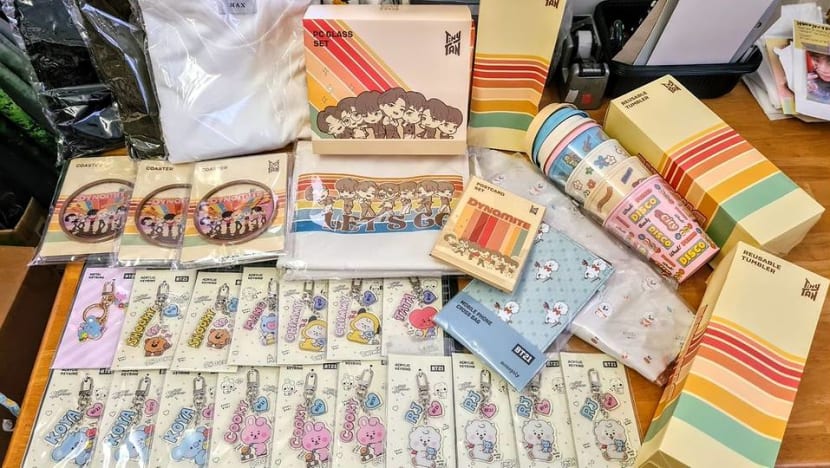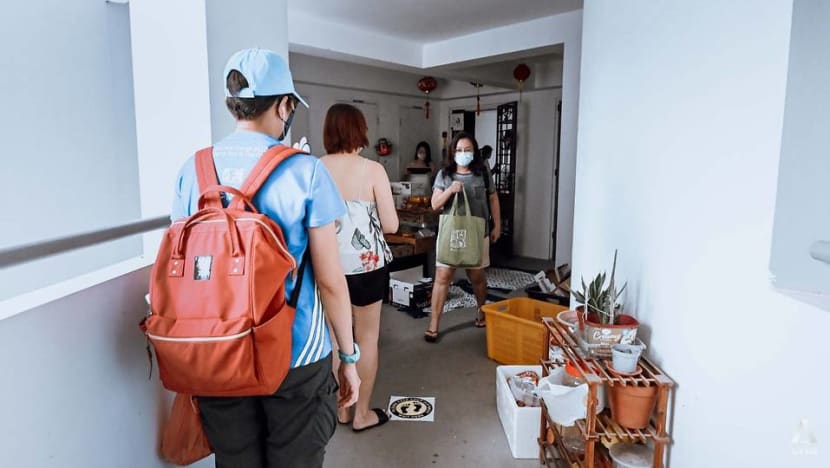Not just free delivery and bulk discounts: The rise of community group buys in Singapore
Some started off just wanting their food delivered with no extra charge. These group-buy hosts now collate orders for hundreds of people at a time — and make new friends in the process.

Group buy hosts Ashley Teo (left) and Cheryl Guo preparing orders for fresh fruits for collection. (Photo: Hanidah Amin)
SINGAPORE: In the year or so since Mrs Tan began joining group buys, she has seen everything from high-quality fresh fruits to microfibre cloths to ergonomic chairs being hawked at a discount.
Today, the 31-year-old, who wished to be identified by her last name only, estimates that half her groceries come from orders placed through chat groups on WhatsApp or Telegram run by others in her estate.
“While the prices weren’t necessarily cheaper than in a neighbourhood supermarket, we felt the fruit and vegetables were significantly fresher than what we were getting. We eat a lot better with the same amount of money,” she said.
She also appreciated the flexibility and convenience of being able to pick up her items at her neighbours’ homes.
This process, known as group buying, involves people in the same estate banding together to place bulk orders for items in order to cut delivery costs and enjoy discounts from suppliers.
And it is gaining traction in Singapore, fuelled by COVID-19 restrictions. A simple search on Instagram yields more than 50 group-buy profiles tagged with the names of different estates.
Group buys have also sprung up island-wide based on shared interests, like for those buying children’s toys or for couples looking to renovate their homes.
But even as it appears that the primary aim of group buys is to get a good deal, other side benefits have emerged along the way. Even hawkers are benefiting, though the question remains: To what extent?
And while there is uncertainty about breaching regulations in running group buys, the positives outweigh the drawbacks, so far, for the likes of Mrs Tan.
FOR THE LOVE OF FOOD
Group buying has actually existed since the noughties, but in a slightly different form: E-commerce site Groupon Singapore.
“It had many of the same characteristics of the group buys we know now: You bring a lot of customers to get a huge volume of sales in exchange for big discounts,” said National University of Singapore Business School assistant professor of marketing Daniel He.
Once popular with consumers, Groupon’s market share went down over the years, and it evolved into a model where the group buy component became “very minor”, according to Nanyang Business School deputy dean Boh Wai Fong.
Both professors agreed that the latest iteration, community-led group buying, has experienced its recent rocketing popularity riding on the back of the circuit breaker and other pandemic restrictions.
READ: For some businesses, enhanced online browsing to drive sales could become a new norm
Indeed, almost all the estate-based group-buy hosts CNA Insider spoke to had got their start during the circuit breaker.
For former cabin crew member Cherie, who runs a group buy in the Changi Simei area, it started out as a way of finding neighbours to share the delivery cost of food.
“Anybody who lives in Simei would tell you the same thing: They’ve been eating the same food from the same hawker stalls since the beginning of time,” said the 28-year-old, who preferred to be known by her first name only.
“It’s not financially sustainable for one person to be ordering food from 10 different businesses and paying a S$10 delivery fee 10 times, so I thought this would address the gap and give the community more options.”
With time on her hands after the circuit breaker, she started an Instagram account to reach out to more people who might be interested in joining her group buys. She also went around her estate distributing flyers.
Her group chat now has just over 250 participants — a modest number compared to others, she said. But on average, she gets free delivery for about seven in 10 of her group-buy orders.
At the other end of the spectrum in terms of size is Sengkang Group Buy, which has 7,500 followers on Instagram and four WhatsApp group chats among its social media platforms.
It was started in May last year by friends Cheryl Guo, 33, and Ashley Teo, 34, who live in neighbouring blocks, after Cheryl noticed the trend on the Hawkers United – Dabao 2020 Facebook page, which gained popularity during the circuit breaker when dining out stopped for the first time.

“I went to join the group to see what food I can order, and I saw a lot of people commenting on a post asking, ‘Who’s staying in Sengkang? Let’s group-buy together,’” she recalled.
She participated in a group buy for Swiss rolls before deciding to start one with Ashley.
Their group buys have expanded to include, on occasion, pillows, hand sanitiser, skincare products and even staycation deals after vendors reached out to them, drawn to their collective buying power.
LOW ENTRY BARRIER, BUT THERE ARE CHALLENGES
The barriers to organising a group buy are low. When Mrs Tan — who started her group buys with frozen fish soup — wanted to try nitrate-free sausages, she decided to ask the supplier if group discounts were available, and there were.
As her group buys are on a small scale, the logistics are simple and it is “not much of a sacrifice”, she said, to do the administrative work of collating orders on a spreadsheet and to liaise with the supplier.
But for others, the work can be more intense. Cheryl estimated that she spends, on average, two to three hours daily on admin, such as doing Google forms to collate orders, answering customers’ questions, checking payments and managing social media.

“It can drain my energy sometimes,” she said, adding that juggling this with her full-time marketing job can be tough.
There can also be hiccups, like customers who forget to collect items or pay for them.
That was something Rachel Lum had to deal with when she used to organise a group buy in her condominium by shopping with Treedots, a social enterprise that matches buyers to surplus meat and seafood sold by suppliers.
For S$18.80, she could get five kilogrammes of fresh chicken breast, split among her neighbours. But not receiving timely payments was a slight price to pay.
“If it was just one person, I’d send a private message. But if that person didn’t respond, I’d tag the person in the group as a reminder,” said the 36-year-old.
Camay Goh, who organises group buys in Yishun, has faced issues with buyers who do not collect their items on time.

So she has instituted “house rules” of sorts: Frozen food will be confiscated if not collected by the end of the day, while other items like crackers can be stored for up to three days.
“Otherwise, there won’t be space to walk in my house,” said the 28-year-old.
Over in Zoe Wong’s four-room flat, one room is set aside for storing the items her customers have ordered. These range from small products, like toothpaste made from natural ingredients, to bulky items like high chairs and tricycles.
The 35-year-old is co-founder of Group Buy Queens, which focuses on children’s products. She and her partner, Eva Pu, 37, source products from China, handle the shipping, liaise with vendors and charge customers a lump sum, which includes delivery fees.

Then there is Mandy Lee, who runs large group orders for merchandise from Korean boyband BTS. She sees parcels arriving at her flat, which she shares with her parents, as often as 10 times a day.
“The delivery men all know me already,” said the 34-year-old.
For their efforts, some group-buy hosts collect an admin fee or take a commission from vendors. Cheryl charges a S$2 fee per order, but she stressed that her group buy was primarily a “passion project” rather than a money-making venture.
Mandy, meanwhile, charges customers only enough to cover costs such as the shipping to Singapore and credit card fees.
For her, there are other benefits. The number of orders she places allows her to achieve “Super VIP” status on some websites, which means she can get discounts to offset the cost of her own merchandise.

WIN-WIN DEAL
Experts say group buys are a win-win deal for both customers and businesses. “For customers, the low price is great. And for the businesses, they like bulk orders because there’s a very stable recurring revenue,” said Asst Prof He.
Group buying, he added, comes under a new business model called consumer-to-manufacturer (C2M), which involves “finding opportunities to cut out the middleman”.
Take, for example, a farm selling produce to a wholesaler, which is then sent to a distributor and eventually the grocer’s.
“You cut all of them out, now all of a sudden, you have huge savings that you can pass on to customers,” he said.
But the line between group buying and other models of online shopping such as drop shipping has been blurred.
Drop shipping involves the direct delivery of a product from the manufacturer or supplier to customers. For group buys, the focus is on negotiating with the seller, and hosts need not get their items directly from the manufacturer or supplier.
“They both buy in bulk, and there’s also the chance that group-buy hosts could buy from a manufacturer or wholesaler. It doesn’t restrict them from doing so,” said Prof Boh.
In the case of Group Buy Queens, about 80 per cent of the items come direct from the manufacturer, Zoe estimated. This includes high chairs, foldable car seats and learning towers.

Her partner, Eva, is from China and uses her family’s contacts there to source manufacturers.
The pair, both mothers of young children, stressed that they are very particular about the quality of these items. They order samples first to assess the quality and then post their reviews on Instagram before opening a group buy.
“We’re quite open with our reviews,” said Zoe. “When we assess the items, we’d say what we like and what mothers might need to consider before they buy.”
SMALL BUSINESSES BENEFIT TOO
Banding together does not just help customers get a great deal. Home-based businesses and hawkers can also benefit.
READ: Home-based F&B businesses flourish amid pandemic
Home-based business Lindle SG, which sells dry mee siam and ngoh hiang, gets about 80 per cent of its orders through group buys. It is run almost single-handedly by one woman, known as Auntie Linda, who does the marketing, cooking and delivery.
“With group buys, my aunt can drop everything off at one location, instead of having to go to six different locations within two hours to make the lunch deliveries,” said Chloe Zhang, a family member who helps out occasionally.
"This means she doesn’t need to rush and has more time to go back home and prepare for the dinner deliveries."
Even popular hawker stalls like Xing Ji Rou Cuo Mian at Fengshan Food Centre can benefit from reaching new markets.

Since it started working with group-buy hosts about a year ago, it has delivered packets of their bak chor mee (minced meat noodle) to locations as far away as Jurong West and Bukit Panjang.
“There are very few of us who make soup-based bak chor mee,” said stallholder Sim Chee Moey.
Her daughter, Lim Ke Er, added: “People in the west may not know about or have tried it, so these group buys have helped connect us with them.”
READ: Floundering in digital wave, older hawkers could call it quits — taking a piece of Singapore with them
But how much of a difference does it make for hawkers? They cannot put a number to how much group buys have helped, owing to the inconsistency of the bulk orders coming in.
Chee Moey said group buys, on average, range from about 40 to 60 packets. But order sizes can vary. One time, she received an order for 200 packets, although she stressed that it was a rare incident.
There is also no telling when, or how often, hosts come knocking. “Sometimes we only work with them once, and that’s all,” said Ke Er. “They’d also want to cater other food for their members.
“They can’t always eat ours — it’d be very sian (boring).”
They are nonetheless grateful for the extra business.
Heng Check Kwang, who runs Ah Heng Curry Chicken Bee Hoon Mee at Hong Lim Food Centre, said the “10 to 20 per cent” earnings boost from group buys helped to “lessen the burden” of running a hawker stall in the Central Business District during the circuit breaker.
“Every little bit helps,” the 61-year-old said, citing a drop in business of about 50 to 60 per cent overall.
For this reason, Cherie from Changi Simei Group Buy does not take a cut or ask for bulk discounts from vendors.
“If the uncle is going to sell you char kway teow for S$4, how can you ask him for a discount?” she said. “I don’t have the heart to undercut all these people.”
She also makes a point of supporting businesses doing good.
For example, after finding out about Project Cookoh, an initiative of volunteer organisation ReadAble to help mothers in the Jalan Kukoh neighbourhood start home-based food businesses, she decided to tie up with them to bring their food to Simei.
READ: Jalan Kukoh's enterprising mums make popiah and begedil to ride out COVID-19
“I feel that group buys can be used to help the community in general as well, not just to eat,” she said.
SMELLS LIKE KAMPUNG SPIRIT
What started out as a means to get good deals — and support a favourite hawker — has had another welcome side effect: Stronger bonds among neighbours and friends.
Mandy has made many friends through her group buys, and even travelled to Korea to watch a BTS concert with a customer with whom she reconnected.

“There are a lot of closet K-pop fans who like the band but don’t dare to say they do, because there’s a certain stereotype,” she said.
“I’ve met a lot of people who are solo fans like me, who don’t have other people to share their interests with.”
Some of them have become “very good friends”, she said, and they “hang out whether or not they buy anything”. Others give her small gifts or cakes when they collect their items. “We’re all fans, so we’re tight,” she added.
The estate-based group buys have also turned neighbours into friends. Members of Yishun Group Buy often chit-chat on WhatsApp and share other good deals in the area, such as at new shops in the neighbourhood malls.

“We also go out and eat together, and celebrate occasions,” said Camay. “We wouldn’t have known each other without this group buy.”
Over in Sengkang, the table set up outside Cheryl’s house for people to collect their buys attracted the attention of neighbours who had never gone beyond exchanging greetings.
“Some of them came up to me and asked me what I was selling,” she recalled. “After that, they said they wanted to join.”
Today, they are friends. She often hangs out in one of their homes to work or just spend time together. On collection days, she can count on them to lend a hand. “We do everything together now,” she joked.
While she says that her immediate neighbours do not mind her activities and have joined her group buys at one point or another, she ensures that her activities do not bother them.
“As long as I don’t block their walkway, they’re okay,” she said.
Cheryl and Ashley also ensure that customers practise safe distancing, should a crowd form during collection. Only one person per household is allowed to come up to the unit to collect items.

Camay, meanwhile, requests that her customers text her when they are five minutes away, so she can leave their items in a Styrofoam box outside her door — collections are thus contactless.
Are group-buy hosts worried, however, that they are breaching any regulations for running home-based businesses?
“We’ve done this for a year … If it isn’t allowed, I think someone would’ve come by now,” said Ashley. “We’re playing it by ear for now. If we hear we aren’t allowed to do it, we’d adhere to it.
“We’re not setting out to intentionally break any rules.”
According to provisions listed on the Urban Redevelopment Authority website, small-scale businesses with restricted activities are allowed in homes. Examples of allowed activities include baking cakes and conducting private tuition for not more than three students at a time.

HERE TO STAY?
Not everyone is a fan of group buys. When CNA Insider asked on Instagram for readers’ views on group buys, one user commented: “They make goods from merchants go out of stock real fast, and I can’t get my stuff.”
There are also pitfalls like overconsumption.
“Sometimes you see something, you want to help your neighbours hit the minimum spend, and then you find it languishing at the back of your cupboard,” said Mrs Tan. “This is something I’ve learned and tried to avoid.”
But are group buys here to stay, and in what guise?
If the Chinese example is anything to go by, cited Asst Prof He, Singapore could see e-commerce platforms muscling in on the act and possibly crowding out individual community hosts.
Recently, China has seen the meteoric rise of Pinduoduo, which offers discounts to users who invite their friends to join in their purchase.
“Those doing this at the grassroots level can only bring in maybe a few hundred customers. But the platforms could bring in millions,” said Asst Prof He.
But for now, the hosts in Singapore are happy to let their activities remain a side project. Almost all of those CNA Insider spoke to hold full-time jobs and are doing group buys in their free time.
“This is not about making money,” said Mandy. “It can be tiring, tedious at times, but the whole buying process is very fun.”



















